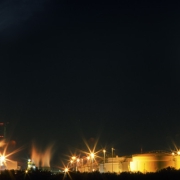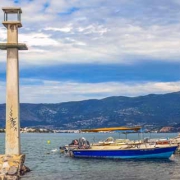Going nuclear – LNG’s natural friend
Nuke power is commonly seen as a big competitor to LNG as a primary energy source. I disagree. They are like the Yin and the Yang and complement each other. Here is why.
Funny, isn’t it? Not too long ago the world of nuclear power enthusiasts was shaken to the bone by the Fukushima incident. Now – a pro-nuclear party has won the general elections in Japan. A few nuclear power plants are up and running and the total phase-out of nuclear power in Japan has been put so far into the future that no current politician needs to worry about it.
Call me foolish but I have a hunch that the German decision to pull out of nuclear will be revised at some point in the future as well. Let’s face it. Handled sensibly, nuclear power has a terrible lot of advantages over other forms of primary energy.
For most LNGaholics, nuclear power and LNG are competitors. I certainly belong to the crazy LNG nutbags but for me, nuclear has always been the logical complement to LNG. Or LNG the complement to nuclear?
This is a bit hard to stomach for those who see LNG as nothing else than a transport mode for Natural Gas. LNG, so they think, must always be regasified and then used as a further inlet into the gas market competing with the pipeline stuff.
Luckily, more exciting things are happening right now such as the burgeoning LNG as a fuel movement shows well. Suddenly – it’s not LNG to gas competition anymore. Suddenly – it’s liquid fuels to LNG competition. I am a big fan of LNG as a fuel but I will not belabor the LNG v/ diesel argument here. Hang in for another post on that topic in some weeks time.
Our topic is still nuclear and why it’s no enemy of LNG.
I am a convinced fan of LNG as a fuel for – well, let’s say everything that diesel (and even gasoline) can do. There were designs for nuclear-powered cars in the seventies but even a tech enthusiast like me relegates them into the domain of utter folly. So it seems it’s all for LNG’s taking.
Nuke and LNG could not be more different. Nuclear power is the king of cheap baseload. Once built – it makes little sense to switch a nuclear power plant off just because of changes in the demand picture. Very little fuel would be saved from running the reactor at less than optimal operational capacity.
LNG is the king of flexibility. It can be switched on and off very rapidly. And as said, as a liquid, it stays nicely in a vehicle’s tank waiting to be regasified on demand and combusted to produce forward motion (or any other thing you do with internal combustion engines). Again, I will not expand on the problems or be having small amounts of LNG in a vehicle’s tank for some amount of time although there will be a post at some point I reckon.
Back 10 steps: nuclear is out of favor. Since Fukushima – the world has understood that it’s better not to play god and split atoms. In the end, it is all way too dangerous.
Those who think so forget that nuclear incidents are very, very rare, and also virtually all of them have human failure at their origin. But, you will say, if human failure results in colossal accidents such as Fukushima or even Chernobyl, then we sure should not play around with it. Sounds right.
But allow me to retort. The human failure a the source of these nuclear incidents were all easily preventable. In the case of Chernobyl scientists and operators felt a little too sure about their reactor and behaved like stupid children. In the case of Fukushima, a chain of reactor blocks that should have been decommissioned a long time ago (the reactors were commissioned in 1971 – a little after I was born) was hit by a Tsunami. It was the loss of the cooling system that resulted in the incident.
Utter greed of the operator’s managers who wanted to inflate their balance sheet through sales of power from a written-off asset caused deprecated reactors to remain in operation. This form of criminal behavior is not limited to Japan. But it could be prevented through clear rules and intrusive inspections. If handled properly, nuclear power is a very safe energy form as France and a couple of other countries prove well.
Even better, there is a whole new generation of nuclear reactors under development that will revolutionize the trade. Smaller, much safer, cheaper, and inherently flexible. Several designs are under development from Hyperion through to the Toshiba design many of them supported by the DoE SMR /(Small Modular Reactors) initiative.
Old nuclear reactors meant building cooling towers at a river location, a very large concrete building a custom-made reactor at the location, and a strong distribution grid to bring the electricity to the customer.
Those mini units will be self-regulating which means they can never blow up as the process automatically slows as they get hotter. They will also be modular which brings production costs down and makes them transportable by rail or a barge according to DoE specifications. Each mini-reactor will be encased in concrete at a central location and buried at the place of operation. Underlying technology is what is being used in nuclear submarines and aircraft carriers.
One of those units would supply 20,000 homes with electricity and produce power for 5 years. Then it is swapped for a new one and the old reactor is processed at the central facility again. They would as “off the shelf” as it get in this trade and sold to utilities everywhere. They would also be invulnerable to terrorist attacks as there is no control room or process to tamper with, and accessing it would involve digging a large hole – hardly the kind of activity that can be accomplished in a few hours and goes by unnoticed.
You must have noticed that I am a fan already now. But how is that beneficial to LNG you will ask? This is competition to LNG as every MWh of nuke power will replace LNG-powered generation.
And herein lies the beauty of it all. I was never convinced that it was a good idea to do all this expensive liquefaction in the first place and then do nothing but regasify on the first occasion in order to blow Natural Gas (regasified LNG) into a gas turbine. LNG has properties that are much superior to Natural Gas. With LNG, Natural Gas becomes much more mobile.
You don’t need the pipe anymore. It behaves very similarly to other liquid fuels. You can fill it in a tank, it has pretty good energy density, and as a huge bonus, it’s cleaner than any other liquid you can have in your tank. LNG is a perfect fuel for vehicles. Technically a bit more complex than diesel – admitted – but this is no problem at all if sensibly handled.
Before I now get taken away about the great qualities of LNG as a fuel (as I will repeatedly in many other posts), let’s go back to the core rationale. It has been said that if all marine traffic converted to LNG as a fuel, the current LNG production of the planet would have to be doubled to fill that need only. I did not account for onshore vehicular traffic, I did not account for island gasification (for which LNG is the only option), I did not account for exotic uses of LNG such as powering rigs or fuel cells in basements of buildings or for some peak shaving storage. And big baseload LNG is not about to disappear in one day either.
Consequently, the world will need a huge lot more LNG and it will become a vastly better (cleaner) place in the process. Nuclear baseload power would free up much of the LNG currently produced for superior fuel use. Nuke power would hence help get rid of 19th-century dirty diesel in order to ring in 21st-century clean LNG. I am lovin it.


















Leave a Reply
Want to join the discussion?Feel free to contribute!